POLAR
GRAPH PLOTTER
By TUONG (Tom) TRAN
By TUONG (Tom) TRAN
To plot a polar graph with a pencil and paper takes a lot of time, but with a computer this is an easy task. By using graphics mode 8 on the ATARI it s quite simple to make some excellent looking polar graphs. This program is a very helpful teaching tool because a polar graph can be plotted very quickly by just entering in your function.
Suppose we had a relation between R, the distance from a point called pole, and T(Greek symbol theta), the angle measured counter clockwise from the polar axis. The pole is analogous to the origin axis and lies along the X-axis. The relation between R and T(heta) is usually described by an equation of the form:
R=F(T)
The equation:
R=90*SIN(2*T)
is one example. Refer to Diagram 1 for an illustration of some of these
concepts, including a graph of the equation R=90*SIN(2*T), called a
four-leaved rose.The key to using a computer to graph polar coordinates is the transformation formulas:
X=R*COS(T)
Y=R*SIN(T)
and of course, the computer's ability to perform a PLOT X,Y instruction.Y=R*SIN(T)
Below are eight other diagrams with their functions that you can type into the program.
DIAGRAM 1. A Four-Leaved Rose.
R=90*SIN(2*T)
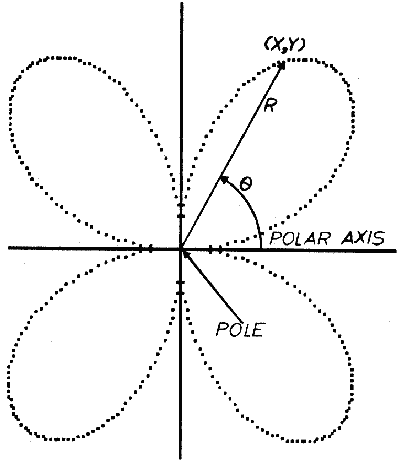
DIAGRAM 2. A Three-leaved Rose.
R=80*SIN(3*T)

DIAGRAM 3. A Thirteen-Leaved Rose.
R=80*SIN(3*T)
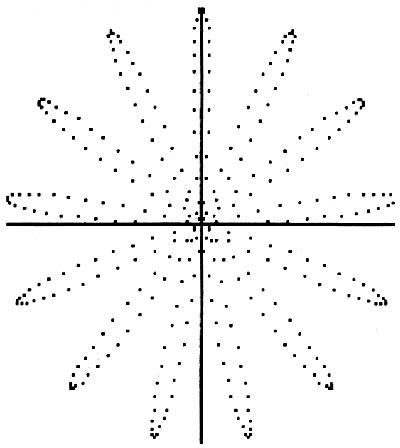
DIAGRAM 4. Bear-Head.
R=25*(2+SIN(3*T))
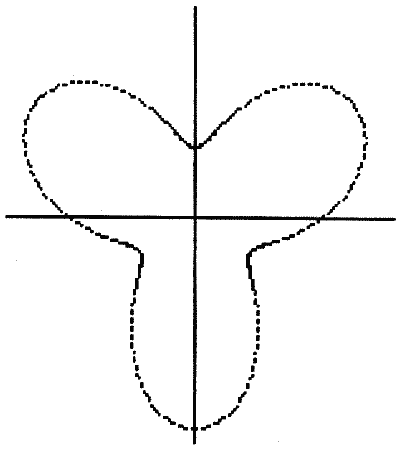
DIAGRAM 5. The Cardioid.
R=40*(1+COS(T))
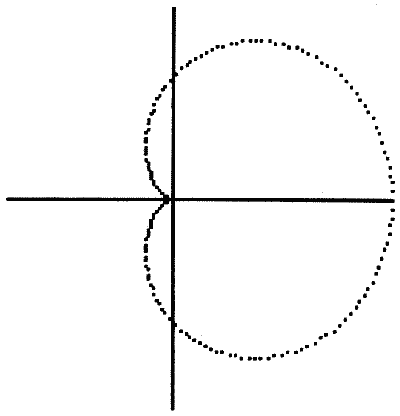
DIAGRAM 6. The Spiral of Archimedes.
R=0.05*T
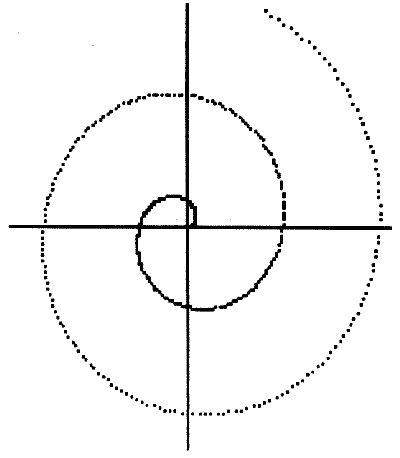
DIAGRAM 7. Inward Circle.
R=80*COS(T/3)

DIAGRAM 8. Swirl.
R=SQR(360000/T)

The program below allows one to type in a polar graph function and watch the graph draw on the screen. It uses EQ$ to store the function you enter so that if you wish to go back to it to edit it you can. A sample function is given at line 0 in order to show you the form. When you enter in a function that the computer doesn't understand it will give you an error message that will flash on the screen. You then can go back and edit the function you typed in. After you enter in your function the program will ask you if you want to set the increment. If you say no it will set the increment at 1. If you say yes you can tell it how large of an increment and how many revolutions that you want it to go. Remember for Theta all you need to type in is a T so that there could be room for larger functions. If you get any interesting graphs feel free to send in the functions.
1 REM *******************************
2 REM * TWO DIMENSIONAL POLAR PLOTS
3 REM * WRITTEN BY: Tom Tuong Tran
6 REM *******************************
9 DEG :REM -THIS PROGRAM WILL WORK IN DEGREE
10 ? "
 ":DIM FUC$(60),EQ$(60),A$(3)
":DIM FUC$(60),EQ$(60),A$(3)20 ST=PEEK(560)+256*PEEK(561)+5
30 FOR I=1 TO 2:POKE ST+I,6:NEXT I
40 FOR I=3 TO 4:POKE ST+I,7:NEXT I
50 FOR I=5 TO 11:POKE ST+I,6:NEXT I
60 FOR I=11 TO 17:POKE ST+I,2:NEXT I
70 FOR I=18 TO 20:POKE ST+I,6:NEXT I
80 POKE ST+20,PEEK(560)
90 POKE ST+21,PEEK(561)
100 ? "****************";? "TWO DIMENSIONAL POLAR PLOTS":? : ? "****************"
110 POKE 85,1:? "BY: TOM TUONG TRAN"
120 ? "This program will plot the graph of any given function having the form:":POKE 85,33:? "R=F(T)"
130 ? "EXAMPLE: R=80*COS(6*T) or R=80*SIN(T/3)"
140 ? "for R=Radius and T=Angle in Degree(s)"
150 POKE 85,0:? "PRESS OPTION TO EXIT OR START TO BEGIN"
160 IF PEEK(53279)=3 THEN GRAPHICS 0:END
170 IF PEEK(53279)=6 THEN ? "
 ":GOTO 190
":GOTO 190180 GOTO 160
190 EQ$="80*COS(3*T)"
200 POKE 710,96:COLOR 5
210 GRAPHICS 0:? "YOU CAN PLOT THE TRIGONOMETRIC FUNCTION BY ENTERING EACH FUNCTION IN THE FORM :"
220 ? " R=F(T)"
230 ? " FOR R=RADIUS and T =ANGLE IN DEGREE(S)"
231 ? "↓↓*********************************":TRAP 200
232 ? "↓↓ 1) EDIT PREVIOUS FUNCTION.":? "↓ 2) RUN PREVIOUS FUNCTION.":? " 3) ENTER NEW FUNCTION." ↓
240 ? "↓ 4) QUIT.":? "↓↓WHICH ";:INPUT OPTION
250 ON OPTION GOTO 280,400,280,270
260 GOTO 200
270 GRAPHICS 0:? "
 ":GOTO 20
":GOTO 20 275 REM --ENTER-FUNCTION------
280 OPEN #1,4,0,"E:"
290 POKE 710,100:POKE 712,100:POKE 709,110
300 ? "
 ↓↓ TYPE
IN THE FUNCTION R=F(T)":? "R=";
↓↓ TYPE
IN THE FUNCTION R=F(T)":? "R=";305 IF OPTION=1 THEN ? EQ$:POKE 82,4:? ""
310 INPUT #1,EQ$:? "
 ":POKE 82,2
":POKE 82,2320 CLOSE #1:FUC$="550 R="
330 POSITION 2,5:POKE 709,148
340 FUC$(LEN(FUC$)+1)=EQ$
350 ? FUC$:POSITION 2,10
360 ? "CONT"
370 POSITION 0,2:POKE 842,13:STOP
380 POKE 842,12:POKE 709,202:? "£":POKE 710,100:POKE 712,100:POKE 709,110
400 ?
 ↓SET INCREMENT &
REVOLUTION (Y/N)"
↓SET INCREMENT &
REVOLUTION (Y/N)"410 POKE 764,255:TRAP 670
420 K=PEEK(764):IF K=43 THEN POKE 764,255:GOTO 450
430 IF K=35 THEN POKE 764,255:I=1:RE=1:GOTO 470
440 GOTO 420
450 ? "↓ INPUT INCREMENT ";:INPUT I
460 ? " INPUT NUMBER OF REVOLUTION ";:INPUT RE
465 REM -SET UP SCREEN AND DRAW AXIS
470 GRAPHICS 8:T=0:C=0
480 POKE 710,96:COLOR 5
490 PLOT 159,0:DRAWTO 159,159
500 PLOT 0,79:DRAWTO 319,79:TAB=(40-(LEN(EQ$)+11))/2:IF TAB <0 THEN TAB=0
510 POKE 752,1:POKE 82,TAB:? :? "FUNCTION R=":EQ$:POKE 82,2:IF TAB>O THEN ? :? " PRESS TO EXIT"
515 REM
520 REM -PLOT THE GRAPH-------
525 REM
530 T=T+I
540 IF T>=C*360 THEN C=C+1:T=T+I/RE:? "REV=";C;""
550 R=80*COS(3*T)
560 X=R*COS(T)
570 Y=R*SIN(T):? "X=";INT(X);" ":? "Y=";INT(Y);" "
580 IF X+159>319 OR X+159<0 OR 79-Y>159 OR 79-Y<O THEN 600
590 PLOT X+159,79-Y
600 IF T>RE*360 THEN 630
610 IF PEEK(764)<>255 THEN POKE 764,255:GOTO 630
620 GOTO 530
630 ? CHR$(253);"
 ↓ WOULD YOU LIKE
TO TRY THIS FUNCTION AGAIN R=";EQ$;" (Y/N)":POKE 764,255
↓ WOULD YOU LIKE
TO TRY THIS FUNCTION AGAIN R=";EQ$;" (Y/N)":POKE 764,255640 IF PEEK(764)=43 THEN POKE 764,255:? "
 ":POKE 752,0:GOTO 400
":POKE 752,0:GOTO 400650 IF PEEK(764)=35 THEN POKE 764,255:POKE 752,0:GOTO 200
660 GOTO 640
665 REM -ERROR MESSAGE--------
670 ? "
 ↓
ERROR- In the FUNCTION":? "↓ PLEASE TRY AGAIN"
↓
ERROR- In the FUNCTION":? "↓ PLEASE TRY AGAIN"680 FOR Q=l TO 30:? "↑
 ":FOR
W=1 TO
10:NEXT W:? "↑ ERROR-":FOR W=1 TO 10:NEXT
W:NEXT Q:GOTO 190
":FOR
W=1 TO
10:NEXT W:? "↑ ERROR-":FOR W=1 TO 10:NEXT
W:NEXT Q:GOTO 190